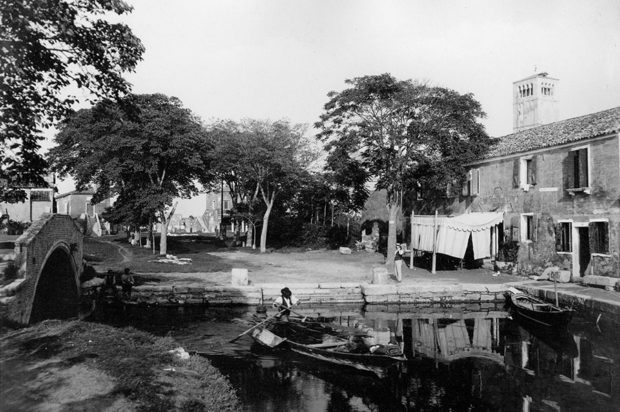The sea has always been the lifeblood of Venice, nicknamed “La Serenissima” (“Most Serene”) because of her unrivaled maritime and commercial importance, from her conquest of Constantinople during the Crusades in 1204 to the Napoleonic era at the end of the 18th century.
With 177 usually narrow and often–sinuous canals instead of streets, the city—the only one in the world without cars—is built on 177 islets connected by 400 footbridges and divided into six sestieri: Cannaregio, San Marco, Castello, Dorsoduro, San Polo, and Santa Croce or neighborhoods. Although no longer a world power this pedestrian’s paradise, where the past is more important than the present, still casts her spell over some 20 million visitors a year.
Naturally flamboyant and overwhelmingly romantic, Venice could only be named after Venus, and like this goddess of love, was born out of the sea. In recognition every year since Pietro Orseolo, the doge or Chief Magistrate, established the custom in 1000 AD, Venice, definitely a prima donna past her prime, is wed to the Adriatic Sea on the Sunday after Ascension at the end of May. Several other annual Venetian feste or celebrations are sea-connected regattas: on April 25th, the feast of St. Mark, a gondola race between the lagoon island of Sant’Elena with its pretty Gothic church and the Punta della Dogana once the sea customs post; in May the Vogalonga or the “Long Row” from Piazza San Marco to the lace-making island of Burano, and back—a distance of 32 km. (20 miles); and the fist Sunday in September the Regata Storica down the Grand Canal.

Thus, it should come as no surprise that except for carpaccio (an appetizer of thinly sliced raw beef), fegato alla veneziana (thinly sliced calf’s liver smothered in onions), and risi e bisi (a risotto made with bacon and fresh peas), Venetian cuisine features a wide variety of seafood from the lagoon and Adriatic Sea beyond. Delectable local specialties include: clams galore, cappesante (scallops not usually found on menus elsewhere in Italy), schie (minuscule sweet gray shrimp), zotoletti (the tiniest of cuttlefish), moscardini (little purple red octopus), and peoci (baby mussels). Also composing a Venetian’s seafood birthright are soaso (light-skinned turbot), mullet, eels, dogfish, passarini (a cousin of the sole) and papamei (boney little gobies), and much more. If you ask an Italian where you eat well in Italy, many say: “everywhere but Venice, because it’s a minefield of overpriced, tourist-trap restaurants offering depressingly mediocre food”, but if you’re heading to Venice to see the Tintoretto exhibitions or visit the Armenian island of St. Lazarus, here are some special places you should eat. There are over 50 choices with Michelin plates for good cooking and eight Michelin one-stars.

Make the first stop on your gourmet tour either the “Caffè Florian”, founded in 1720 and thus the world’s oldest coffee house, or the “Gran Caffè Quadri”, founded in 1775, for a flute of local prosecco. After the arrival in 2017 of the Alajmo brothers, chef Max and sommelier Raf, owners of 3 Michelin-starred “Le Calandre” outside of Padua, the food at “Quadri” is considered tops (one Michelin star). Both magnificently decorated Caffès, each with its own orchestra, are on St. Mark’s Square, which Napoleon called “the finest drawing room of Europe”.
Off-the-Beaten-Track away from the suffocating crowds, especially in good weather, head to “Busa alla Torre”(Michelin plate for good cooking) on Murano, the center of glassblowing since 1291, or to “Locanda Cipriani”(Michelin plate) on the island of Torcello with its medieval cathedral and mosaics, where Hemingway wrote Across the River and Into the Trees, or the new 1-Michelin star resort “Venissa” on the island of Mazzorbo off Burano, with its myriad choice of possible activities. The latter two also offer rooms.

Speaking of the seven 1-starred star restaurants downtown, don’t miss “Osteria alle Testiere”, the 20-seat gem decorated with testiere or headboards, also a favorite with locals, where the chef Bruno Gavagnin changes his menu daily depending on what’s available at La Pescheria or local fish market, or “Da Fiore”, where the self-effacing chef Mara Zanetti, who inherited her passion for cooking from her caterer paternal grandmother, also changes her menu daily. Both have exceptional wine lists. The others are “Dopolavoro”, “Il Ridotto”, “Met” in the Metropole Hotel, “Oro” in the Belmond Hotel Cipriani (on the Giuddecca), and 2018 newcomer Enrico Bartolini’s elegant “Glam”.

If you are looking for something simpler and with local cuisine, I recommend family-run “Antiche Carampane” for its “cassopipa” (spaghetti with spicy shellfish) or triglie dell’imbriago” (red mullet braised in red wine) (Michelin plate). It’s hard to find, but well worth the effort as are “Corte Sconta”, famous for its procession of antipasti, and “Vecio Fritolin”, famous for fish, in a 16th-century palazzo near the Rialto Bridge (both with Michelin plates).


If dinner isn’t what you want, try the city’s cicchetti, which are similar to Spanish tapas. Meaning “nibbles” in local dialect, they can be small portions of marinated scampi, folpetti (baby octopus), and anchovies buried in mozzarella, just to name a view. For the best, go to the atmospheric “Cantina Do Mori”—the city’s oldest bacaro or wine bar (since 1462) or “Vini da Gigio”, famous for its masorini or wild duck or “moeche” (soft-shelled crabs in spring or fall only) (Michelin plate). For local flavor, a typically Venetian evening consists of cicchetti-tasting at several spots at “Osteria ai 40 Ladroni”, “Osteria Anice Stellato” next door, and Osteria dalla Vedova, all with Michelin plates and in Cannaregio, the neighborhood near the railroad station and the ghetto, Europe’s oldest.












